一. 监控端口数据
首先启动Flume任务,监控本机44444端口,服务端;
然后通过netcat工具向本机44444端口发送消息,客户端;
最后Flume将监听的数据实时显示在控制台。
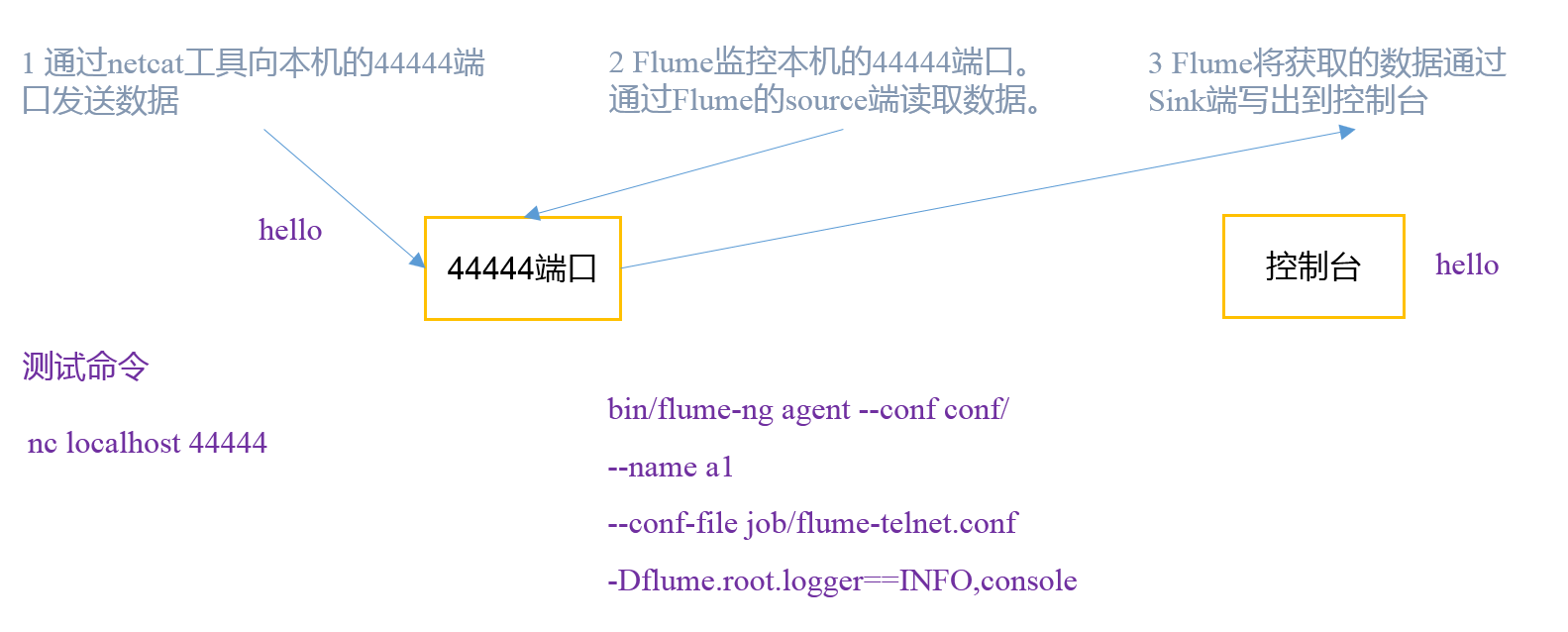
1. 安装netcat
sudo yum install -y nc
功能描述:netstat命令是一个监控TCP/IP网络的非常有用的工具,它可以显示路由表、实际的网络连接以及每一个网络接口设备的状态信息。
基本语法:netstat [选项]
选项参数:
-t或--tcp:显示TCP传输协议的连线状况;
-u或--udp:显示UDP传输协议的连线状况;
-n或--numeric:直接使用ip地址,而不通过域名服务器;
-l或--listening:显示监控中的服务器的Socket;
-p或--programs:显示正在使用Socket的程序识别码(PID)和程序名称;
2. 判断端口是否被占用
sudo netstat -tunlp | grep 44444
3. 创建Flume Agent配置文件flume-netcat-logger.conf
#在flume目录下创建job文件夹并进入job文件夹。 mkdir job cd job/ #在job文件夹下创建Flume Agent配置文件flume-netcat-logger.conf touch flume-netcat-logger.conf
在flume-netcat-logger.conf文件中添加如下内容。
# Name the components on this agent
#a1表示agent的名称 a1.sources = r1 #r1表示a1的输入源source a1.sinks = k1 #k1表示a1的输出目的地sink a1.channels = c1 #c1表示a1的缓冲区channel # Describe/configure the source a1.sources.r1.type = netcat #表示a1的输入源为netcat端口类型 a1.sources.r1.bind = localhost #表示a1监听的主机地址 a1.sources.r1.port = 44444 #表示a1监听的端口 # Describe the sink a1.sinks.k1.type = logger #表示a1的输出目的地是控制台的logger类型 # Use a channel which buffers events in memory a1.channels.c1.type = memory #表示a1的channel类型为memory类型 a1.channels.c1.capacity = 1000 #表示a1的channel总容量是1000个event a1.channels.c1.transactionCapacity = 100 #表示a1的channel传输时收集到100条event后再去提交事务 # Bind the source and sink to the channel a1.sources.r1.channels = c1 #表示将r1和c1连接起来 a1.sinks.k1.channel = c1 #表示将k1和c1连接起来
其他参数或参数详解,请参阅官方手册http://flume.apache.org/FlumeUserGuide.html
4. 开启Flume监听端口
#第一种写法: bin/flume-ng agent --conf conf/ --name a1 --conf-file job/flume-netcat-logger.conf -Dflume.root.logger=INFO,console #第二种写法: bin/flume-ng agent -c conf/ -n a1 –f job/flume-netcat-logger.conf -Dflume.root.logger=INFO,console
开启后会阻塞
参数说明:
--conf conf/ :表示配置文件存储在conf/目录
--name a1 :表示给agent起名为a1
--conf-file job/flume-netcat.conf :flume本次启动读取的配置文件是在job文件夹下的flume-telnet.conf文件。
-Dflume.root.logger==INFO,console :-D表示flume运行时动态修改flume.root.logger参数属性值,并将控制台日志打印级别设置为INFO级别。日志级别包括:log、info、warn、error。
5. 使用netcat工具向本机的44444端口发送内容

6. 在Flume监听页查看接收数据

二. 实时读取本地文件到HDFS
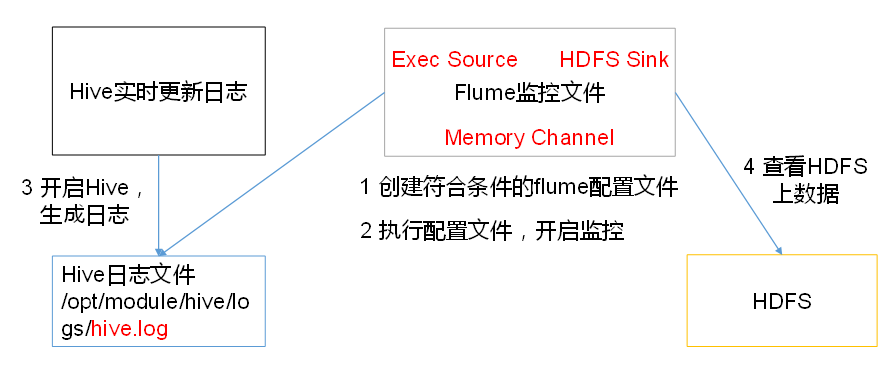
1. 让Flume持有Hadoop相关jar包
将commons-configuration-1.6.jar、
hadoop-auth-2.7.2.jar、
hadoop-common-2.7.2.jar、
hadoop-hdfs-2.7.2.jar、
commons-io-2.4.jar、
htrace-core-3.1.0-incubating.jar
拷贝到/opt/module/flume/lib文件夹下(如果已经持有的话,略过)。
2. 创建flume-file-hdfs.conf文件
#在hob目录下创建文件 touch flume-file-hdfs.conf
要想读取Linux系统中的文件,就得按照Linux命令的规则执行命令。由于Hive日志在Linux系统中所以读取文件的类型选择:exec即execute执行的意思。表示执行Linux命令来读取文件
在flume-file-hdfs.conf中添加如下内容
# Name the components on this agent a2.sources = r2 a2.sinks = k2 a2.channels = c2 # Describe/configure the source a2.sources.r2.type = exec #定义source类型为exec可执行文件 a2.sources.r2.command = tail -F /opt/module/hive/logs/hive.log #要执行的linux命令 a2.sources.r2.shell = /bin/bash -c #执行shell脚本的绝对路径 # Describe the sink a2.sinks.k2.type = hdfs #sink类型为hdfs a2.sinks.k2.hdfs.path = hdfs://hadoop100:9000/flume/%Y%m%d/%H #上传文件再hdfs上的路径 转义序列的详解见下表
#上传文件的前缀 a2.sinks.k2.hdfs.filePrefix = logs- #是否按照时间滚动文件夹 a2.sinks.k2.hdfs.round = true #多少时间单位创建一个新的文件夹 a2.sinks.k2.hdfs.roundValue = 1 #重新定义时间单位 a2.sinks.k2.hdfs.roundUnit = hour #是否使用本地时间戳 a2.sinks.k2.hdfs.useLocalTimeStamp = true #积攒多少个Event才flush到HDFS一次 a2.sinks.k2.hdfs.batchSize = 1000 #设置文件类型,可支持压缩 a2.sinks.k2.hdfs.fileType = DataStream #多久生成一个新的文件 a2.sinks.k2.hdfs.rollInterval = 60 #设置每个文件的滚动大小 a2.sinks.k2.hdfs.rollSize = 134217700 #文件的滚动与Event数量无关 a2.sinks.k2.hdfs.rollCount = 0 # Use a channel which buffers events in memory a2.channels.c2.type = memory a2.channels.c2.capacity = 1000 a2.channels.c2.transactionCapacity = 100 # Bind the source and sink to the channel a2.sources.r2.channels = c2 a2.sinks.k2.channel = c2
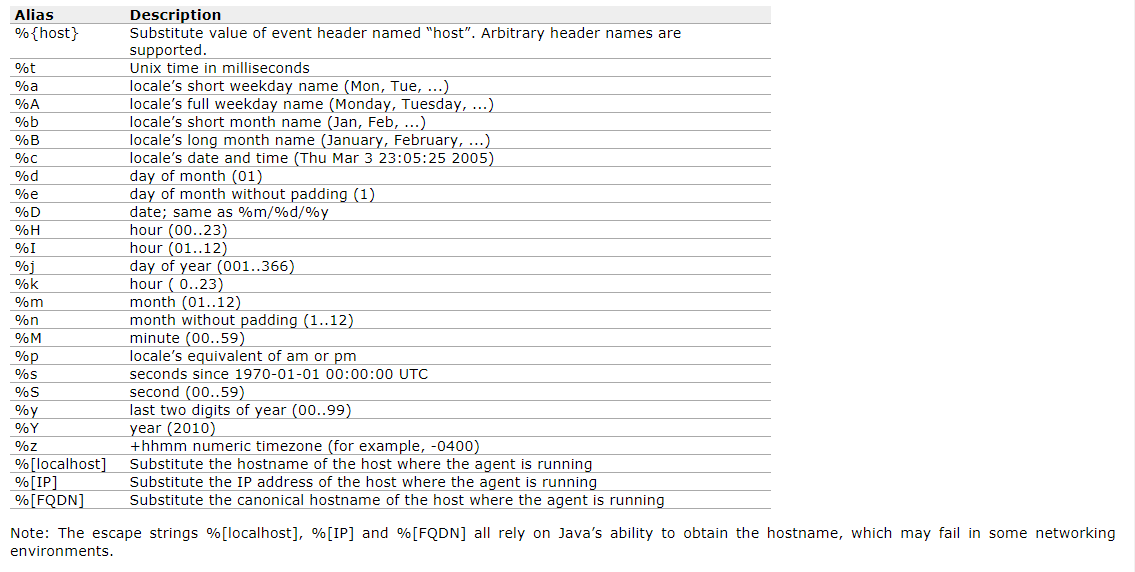
注意 : 对于所有与时间相关的转义序列,Event Header中必须存在以 “timestamp”的key(除非hdfs.useLocalTimeStamp设置为true,此方法会使用TimestampInterceptor自动添加timestamp)。
3. 开启Flume监控
bin/flume-ng agent --conf conf/ --name a2 --conf-file job/flume-file-hdfs.conf
4. 开启hdfs和hive,操作hive产生日志
#开启hdfs sbin/start-dfs.sh #开启hive产生日志 bin/hive
5. 在HDFS上查看文件

三. 实时读取目录文件到HDFS

1. 创建配置文件flume-dir-hdfs.conf
#再job目录下创建文件 touch flume-dir-hdfs.conf
添加以下内容
a3.sources = r3 a3.sinks = k3 a3.channels = c3 # Describe/configure the source #source类型为spooldir a3.sources.r3.type = spooldir #监控的目录 a3.sources.r3.spoolDir = /opt/module/flume/upload #文件上传完后的文件后缀 a3.sources.r3.fileSuffix = .COMPLETED #是否有文件头 a3.sources.r3.fileHeader = true #忽略所有以.tmp结尾的文件,不上传 a3.sources.r3.ignorePattern = ([^ ]*\.tmp) # Describe the sink a3.sinks.k3.type = hdfs a3.sinks.k3.hdfs.path = hdfs://hadoop100:9000/flume/upload/%Y%m%d/%H #上传文件的前缀 a3.sinks.k3.hdfs.filePrefix = upload- #是否按照时间滚动文件夹 a3.sinks.k3.hdfs.round = true #多少时间单位创建一个新的文件夹 a3.sinks.k3.hdfs.roundValue = 1 #重新定义时间单位 a3.sinks.k3.hdfs.roundUnit = hour #是否使用本地时间戳 a3.sinks.k3.hdfs.useLocalTimeStamp = true #积攒多少个Event才flush到HDFS一次 a3.sinks.k3.hdfs.batchSize = 100 #设置文件类型,可支持压缩 a3.sinks.k3.hdfs.fileType = DataStream #多久生成一个新的文件 a3.sinks.k3.hdfs.rollInterval = 60 #设置每个文件的滚动大小大概是128M a3.sinks.k3.hdfs.rollSize = 134217700 #文件的滚动与Event数量无关 a3.sinks.k3.hdfs.rollCount = 0 # Use a channel which buffers events in memory a3.channels.c3.type = memory a3.channels.c3.capacity = 1000 a3.channels.c3.transactionCapacity = 100 # Bind the source and sink to the channel a3.sources.r3.channels = c3 a3.sinks.k3.channel = c3
2. 启动监控
bin/flume-ng agent --conf conf/ --name a3 --conf-file job/flume-dir-hdfs.conf
说明: 在使用Spooling Directory Source时,不要在监控目录中创建并持续修改文件;上传完成的文件会以.COMPLETED结尾;被监控文件夹每500毫秒扫描一次文件变动
3. 向upload文件夹中添加文件

4. 查看HDFS

5. 查看upload文件夹

四. 单数据源多出口(选择器)
使用Flume-1监控文件变动,Flume-1将变动内容传递给Flume-2,Flume-2负责存储到HDFS。
同时Flume-1将变动内容传递给Flume-3,Flume-3负责输出到Local FileSystem。
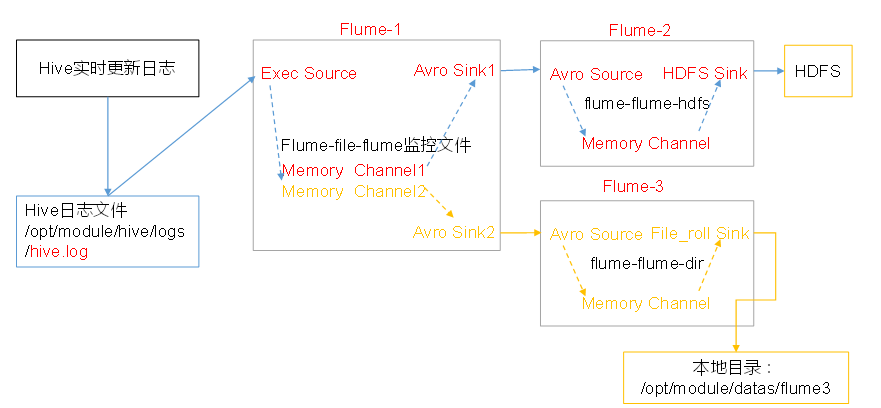
1. 准备工作
#在/opt/module/flume/job目录下创建group1文件夹 mkdir group1 #在/opt/module/datas/目录下创建flume3文件夹 mkdir flume3
2.创建flume-file-flume.conf
配置1个接收日志文件的source和两个channel、两个sink,分别输送给flume-flume-hdfs和flume-flume-dir。
进入group1文件夹,创建flume-file-flume.conf,添加如下内容
# Name the components on this agent a1.sources = r1 a1.sinks = k1 k2 a1.channels = c1 c2 # 将数据流复制给所有channel a1.sources.r1.selector.type = replicating # Describe/configure the source a1.sources.r1.type = exec a1.sources.r1.command = tail -F /opt/module/hive-1.2.1/logs/hive.log a1.sources.r1.shell = /bin/bash -c # Describe the sink # sink端的avro是一个数据发送者 a1.sinks.k1.type = avro a1.sinks.k1.hostname = hadoop100 a1.sinks.k1.port = 4141 a1.sinks.k2.type = avro a1.sinks.k2.hostname = hadoop100 a1.sinks.k2.port = 4142 # Describe the channel a1.channels.c1.type = memory a1.channels.c1.capacity = 1000 a1.channels.c1.transactionCapacity = 100 a1.channels.c2.type = memory a1.channels.c2.capacity = 1000 a1.channels.c2.transactionCapacity = 100 # Bind the source and sink to the channel a1.sources.r1.channels = c1 c2 a1.sinks.k1.channel = c1 a1.sinks.k2.channel = c2
3. 创建flume-flume-hdfs.conf
配置上级Flume输出的Source,输出是到HDFS的Sink.在group1目录下创建flume-flume-hdfs.conf,添加以下内容
# Name the components on this agent a2.sources = r1 a2.sinks = k1 a2.channels = c1 # Describe/configure the source # source端的avro是一个数据接收服务 a2.sources.r1.type = avro a2.sources.r1.bind = hadoop100 a2.sources.r1.port = 4141 # Describe the sink a2.sinks.k1.type = hdfs a2.sinks.k1.hdfs.path = hdfs://hadoop100:9000/flume2/%Y%m%d/%H #上传文件的前缀 a2.sinks.k1.hdfs.filePrefix = flume2- #是否按照时间滚动文件夹 a2.sinks.k1.hdfs.round = true #多少时间单位创建一个新的文件夹 a2.sinks.k1.hdfs.roundValue = 1 #重新定义时间单位 a2.sinks.k1.hdfs.roundUnit = hour #是否使用本地时间戳 a2.sinks.k1.hdfs.useLocalTimeStamp = true #积攒多少个Event才flush到HDFS一次 a2.sinks.k1.hdfs.batchSize = 100 #设置文件类型,可支持压缩 a2.sinks.k1.hdfs.fileType = DataStream #多久生成一个新的文件 a2.sinks.k1.hdfs.rollInterval = 600 #设置每个文件的滚动大小大概是128M a2.sinks.k1.hdfs.rollSize = 134217700 #文件的滚动与Event数量无关 a2.sinks.k1.hdfs.rollCount = 0 # Describe the channel a2.channels.c1.type = memory a2.channels.c1.capacity = 1000 a2.channels.c1.transactionCapacity = 100 # Bind the source and sink to the channel a2.sources.r1.channels = c1 a2.sinks.k1.channel = c1
4. 创建flume-flume-dir.conf
配置上级Flume输出的Source,输出是到本地目录的Sink。在group1目录下,创建flume-flume-dir.conf,添加以下内容
# Name the components on this agent a3.sources = r1 a3.sinks = k1 a3.channels = c2 # Describe/configure the source a3.sources.r1.type = avro a3.sources.r1.bind = hadoop100 a3.sources.r1.port = 4142 # Describe the sink a3.sinks.k1.type = file_roll a3.sinks.k1.sink.directory = /opt/module/datas/flume3 # Describe the channel a3.channels.c2.type = memory a3.channels.c2.capacity = 1000 a3.channels.c2.transactionCapacity = 100 # Bind the source and sink to the channel a3.sources.r1.channels = c2 a3.sinks.k1.channel = c2
注: 输出的本地目录必须是已经存在的目录,如果该目录不存在,并不会创建新的目录。
5. 执行配置文件
分别开启对应配置文件:flume-flume-dir,flume-flume-hdfs,flume-file-flume。
bin/flume-ng agent --conf conf/ --name a3 --conf-file jobs/group1/flume-flume-dir.conf bin/flume-ng agent --conf conf/ --name a2 --conf-file jobs/group1/flume-flume-hdfs.conf bin/flume-ng agent --conf conf/ --name a1 --conf-file jobs/group1/flume-file-flume.conf
6. 启动Hadoop和Hive
#启动hdfs start-dfs.sh #进入到hive目录下,启动hive bin/hive
7. 检查HDFS上数据和/opt/module/datas/flume3目录中数据

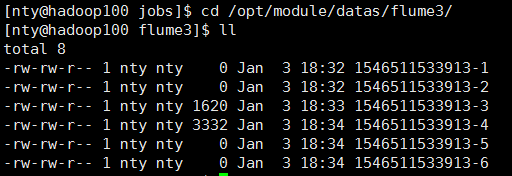
为什么会有6个文件?

file_roll的默认配置是每30秒滚动一次文件.只要没有停止监控,隔30秒去ll一下,就会看到文件又多了
五. 单数据源多出口(Sink组)
使用Flume-1监控文件变动,Flume-1将变动内容传递给Flume-2,Flume-2负责存储到HDFS。同时Flume-1将变动内容传递给Flume-3,Flume-3也负责存储到HDFS

1. 准备工作
#在/opt/module/flume/jobs目录下创建group2文件夹 mkdir group2
2. 创建flume-netcat-flume.conf
配置1个接收日志文件的source和1个channel、两个sink,分别输送给flume-flume-console1和flume-flume-console2。
进入group2文件夹,创建flume-netcat-flume.conf,添加以下内容
# Name the components on this agent a1.sources = r1 a1.channels = c1 a1.sinkgroups = g1 a1.sinks = k1 k2 # Describe/configure the source a1.sources.r1.type = netcat a1.sources.r1.bind = localhost a1.sources.r1.port = 44444 #The component type name, needs to be default, failover or load_balance
a1.sinkgroups.g1.processor.type = load_balance a1.sinkgroups.g1.processor.backoff = true # Must be either round_robin, random or FQCN of custom class that inherits from AbstractSinkSelector
a1.sinkgroups.g1.processor.selector = round_robin a1.sinkgroups.g1.processor.selector.maxTimeOut=10000 # Describe the sink a1.sinks.k1.type = avro a1.sinks.k1.hostname = hadoop100 a1.sinks.k1.port = 4141 a1.sinks.k2.type = avro a1.sinks.k2.hostname = hadoop100 a1.sinks.k2.port = 4142 # Describe the channel a1.channels.c1.type = memory a1.channels.c1.capacity = 1000 a1.channels.c1.transactionCapacity = 100 # Bind the source and sink to the channel a1.sources.r1.channels = c1 a1.sinkgroups.g1.sinks = k1 k2 a1.sinks.k1.channel = c1 a1.sinks.k2.channel = c1
3. 创建flume-flume-console1.conf
配置上级Flume输出的Source,输出是到本地控制台。
在group2目录下,创建flume-flume-console1.conf,添加以下内容
# Name the components on this agent a2.sources = r1 a2.sinks = k1 a2.channels = c1 # Describe/configure the source a2.sources.r1.type = avro a2.sources.r1.bind = hadoop100 a2.sources.r1.port = 4141 # Describe the sink a2.sinks.k1.type = logger # Describe the channel a2.channels.c1.type = memory a2.channels.c1.capacity = 1000 a2.channels.c1.transactionCapacity = 100 # Bind the source and sink to the channel a2.sources.r1.channels = c1 a2.sinks.k1.channel = c1
4. 创建flume-flume-console2.conf
配置上级Flume输出的Source,输出是到本地控制台。
在group2目录下.创建flume-flume-console2.conf,添加以下内容
# Name the components on this agent a3.sources = r1 a3.sinks = k1 a3.channels = c2 # Describe/configure the source a3.sources.r1.type = avro a3.sources.r1.bind = hadoop100 a3.sources.r1.port = 4142 # Describe the sink a3.sinks.k1.type = logger # Describe the channel a3.channels.c2.type = memory a3.channels.c2.capacity = 1000 a3.channels.c2.transactionCapacity = 100 # Bind the source and sink to the channel a3.sources.r1.channels = c2 a3.sinks.k1.channel = c2
5. 执行配置文件
分别开启对应配置文件:flume-flume-console2,flume-flume-console1,flume-netcat-flume。
bin/flume-ng agent --conf conf/ --name a3 --conf-file jobs/group2/flume-flume-console2.conf -Dflume.root.logger=INFO,console bin/flume-ng agent --conf conf/ --name a2 --conf-file jobs/group2/flume-flume-console1.conf -Dflume.root.logger=INFO,console bin/flume-ng agent --conf conf/ --name a1 --conf-file jobs/group2/flume-netcat-flume.conf
6. 使用netcat工具向本机的44444端口发送内容
nc localhost 44444
7. 查看Flume2及Flume3的控制台打印日志
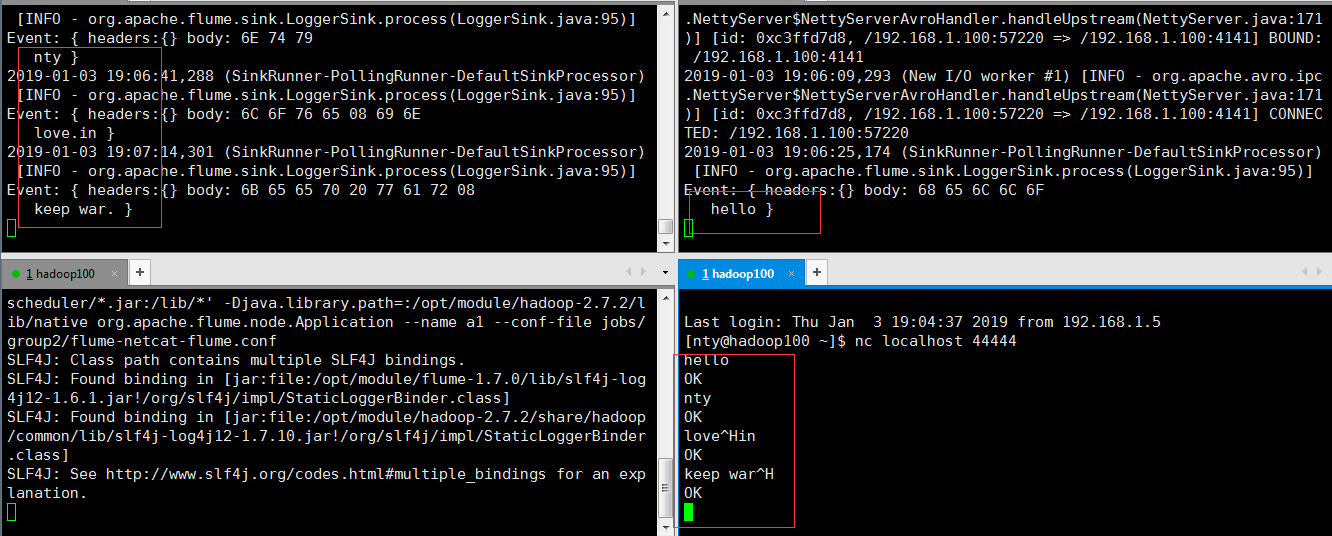
六. 多数据源汇总(常用)
hadoop101上的Flume-1监控文件/opt/module/group.log,
hadoop100上的Flume-2监控某一个端口的数据流,
Flume-1与Flume-2将数据发送给hadoop102上的Flume-3,Flume-3将最终数据打印到控制台

1. 准备工作
如果hadoop101和hadoop102没有安装flume,用分发脚本将flume分发一下
xsync flume-1.7.0/
在hadoop100、hadoop101以及hadoop102的/opt/module/flume/jobs目录下创建一个group3文件夹。
2. 创建flume1-logger-flume.conf
配置Source用于监控hive.log文件,配置Sink输出数据到下一级Flume。
在hadoop101上创建配置文件flume1-logger-flume.conf,并添加以下内容
# Name the components on this agent a1.sources = r1 a1.sinks = k1 a1.channels = c1 # Describe/configure the source a1.sources.r1.type = exec a1.sources.r1.command = tail -F /opt/module/group.log a1.sources.r1.shell = /bin/bash -c # Describe the sink a1.sinks.k1.type = avro a1.sinks.k1.hostname = hadoop102 a1.sinks.k1.port = 4141 # Describe the channel a1.channels.c1.type = memory a1.channels.c1.capacity = 1000 a1.channels.c1.transactionCapacity = 100 # Bind the source and sink to the channel a1.sources.r1.channels = c1 a1.sinks.k1.channel = c1
3. 创建创建flume2-netcat-flume.conf
配置Source监控端口44444数据流,配置Sink数据到下一级Flume:
在hadoop100上创建配置文件flume2-netcat-flume.conf,并添加以下内容
# Name the components on this agent a2.sources = r1 a2.sinks = k1 a2.channels = c1 # Describe/configure the source a2.sources.r1.type = netcat a2.sources.r1.bind = hadoop100 a2.sources.r1.port = 44444 # Describe the sink a2.sinks.k1.type = avro a2.sinks.k1.hostname = hadoop102 a2.sinks.k1.port = 4141 # Use a channel which buffers events in memory a2.channels.c1.type = memory a2.channels.c1.capacity = 1000 a2.channels.c1.transactionCapacity = 100 # Bind the source and sink to the channel a2.sources.r1.channels = c1 a2.sinks.k1.channel = c1
4. 创建flume3-flume-logger.conf
配置source用于接收flume1与flume2发送过来的数据流,最终合并后sink到控制台。
在hadoop102上创建配置文件flume3-flume-logger.conf,并添加以下内容
# Name the components on this agent a3.sources = r1 a3.sinks = k1 a3.channels = c1 # Describe/configure the source a3.sources.r1.type = avro a3.sources.r1.bind = hadoop102 a3.sources.r1.port = 4141 # Describe the sink # Describe the sink a3.sinks.k1.type = logger # Describe the channel a3.channels.c1.type = memory a3.channels.c1.capacity = 1000 a3.channels.c1.transactionCapacity = 100 # Bind the source and sink to the channel a3.sources.r1.channels = c1 a3.sinks.k1.channel = c1
5. 执行配置文件
分别开启对应配置文件:flume3-flume-logger.conf,flume2-netcat-flume.conf,flume1-logger-flume.conf。
#hadoop102 bin/flume-ng agent --conf conf/ --name a3 --conf-file jobs/group3/flume3-flume-logger.conf -Dflume.root.logger=INFO,console #hadoop100 bin/flume-ng agent --conf conf/ --name a2 --conf-file jobs/group3/flume2-netcat-flume.conf #hadoop101 bin/flume-ng agent --conf conf/ --name a1 --conf-file jobs/group3/flume1-logger-flume.conf
6. 在hadoop101上向/opt/module目录下的group.log追加内容

7. 在hadoop100上向44444端口发送数据

8. 观察hadoop102上的数据
